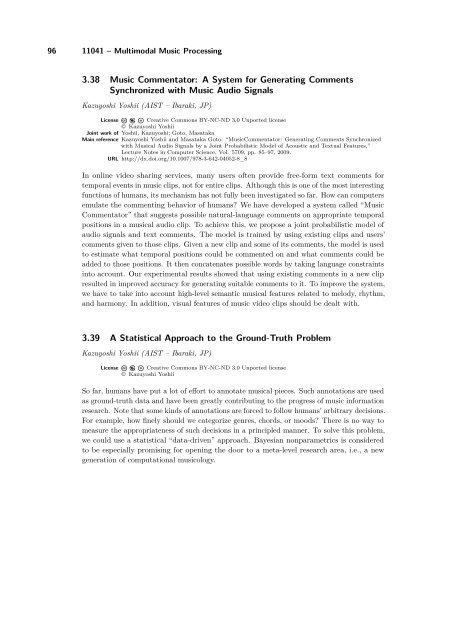Volume 1, Issue 1, January 2011 - DROPS - Schloss Dagstuhl
Volume 1, Issue 1, January 2011 - DROPS - Schloss Dagstuhl
Volume 1, Issue 1, January 2011 - DROPS - Schloss Dagstuhl
Create successful ePaper yourself
Turn your PDF publications into a flip-book with our unique Google optimized e-Paper software.
96 11041 – Multimodal Music Processing<br />
3.38 Music Commentator: A System for Generating Comments<br />
Synchronized with Music Audio Signals<br />
Kazuyoshi Yoshii (AIST – Ibaraki, JP)<br />
License Creative Commons BY-NC-ND 3.0 Unported license<br />
© Kazuyoshi Yoshii<br />
Joint work of Yoshii, Kazuyoshi; Goto, Masataka<br />
Main reference Kazuyoshi Yoshii and Masataka Goto: “MusicCommentator: Generating Comments Synchronized<br />
with Musical Audio Signals by a Joint Probabilistic Model of Acoustic and Textual Features,”<br />
Lecture Notes in Computer Science, Vol. 5709, pp. 85–97, 2009.<br />
URL http://dx.doi.org/10.1007/978-3-642-04052-8_8<br />
In online video sharing services, many users often provide free-form text comments for<br />
temporal events in music clips, not for entire clips. Although this is one of the most interesting<br />
functions of humans, its mechanism has not fully been investigated so far. How can computers<br />
emulate the commenting behavior of humans? We have developed a system called “Music<br />
Commentator” that suggests possible natural-language comments on appropriate temporal<br />
positions in a musical audio clip. To achieve this, we propose a joint probabilistic model of<br />
audio signals and text comments. The model is trained by using existing clips and users’<br />
comments given to those clips. Given a new clip and some of its comments, the model is used<br />
to estimate what temporal positions could be commented on and what comments could be<br />
added to those positions. It then concatenates possible words by taking language constraints<br />
into account. Our experimental results showed that using existing comments in a new clip<br />
resulted in improved accuracy for generating suitable comments to it. To improve the system,<br />
we have to take into account high-level semantic musical features related to melody, rhythm,<br />
and harmony. In addition, visual features of music video clips should be dealt with.<br />
3.39 A Statistical Approach to the Ground-Truth Problem<br />
Kazuyoshi Yoshii (AIST – Ibaraki, JP)<br />
License Creative Commons BY-NC-ND 3.0 Unported license<br />
© Kazuyoshi Yoshii<br />
So far, humans have put a lot of effort to annotate musical pieces. Such annotations are used<br />
as ground-truth data and have been greatly contributing to the progress of music information<br />
research. Note that some kinds of annotations are forced to follow humans’ arbitrary decisions.<br />
For example, how finely should we categorize genres, chords, or moods? There is no way to<br />
measure the appropriateness of such decisions in a principled manner. To solve this problem,<br />
we could use a statistical “data-driven” approach. Bayesian nonparametrics is considered<br />
to be especially promising for opening the door to a meta-level research area, i.e., a new<br />
generation of computational musicology.













